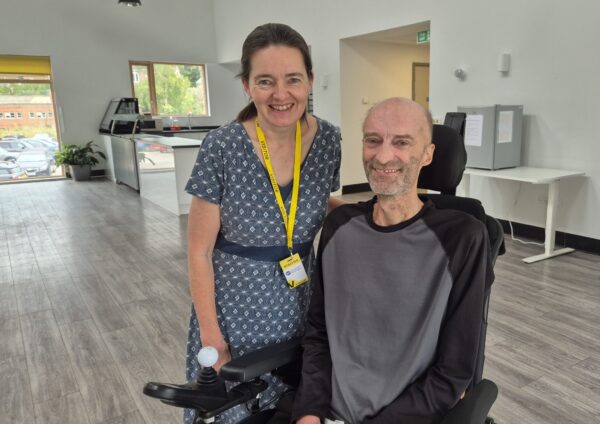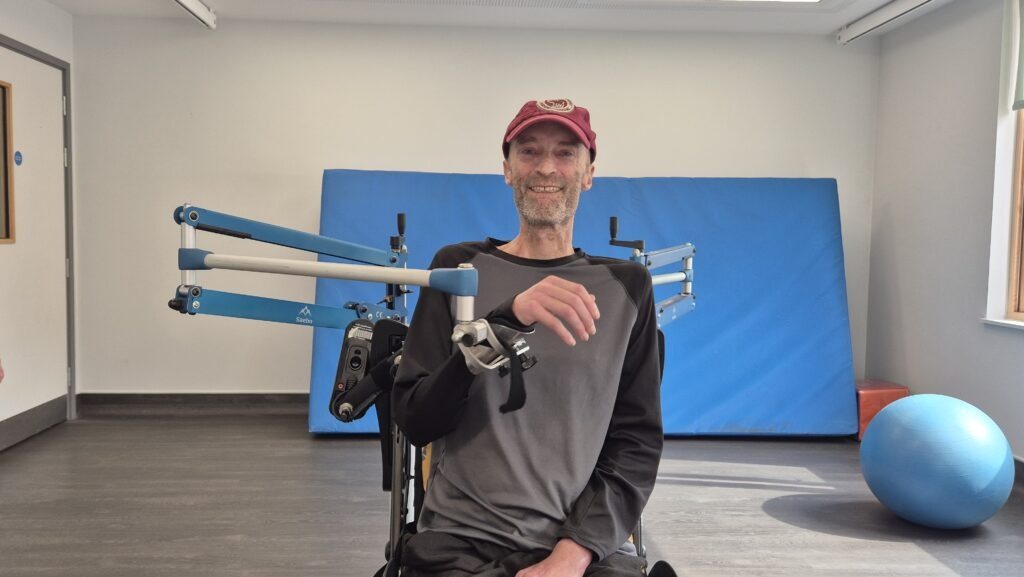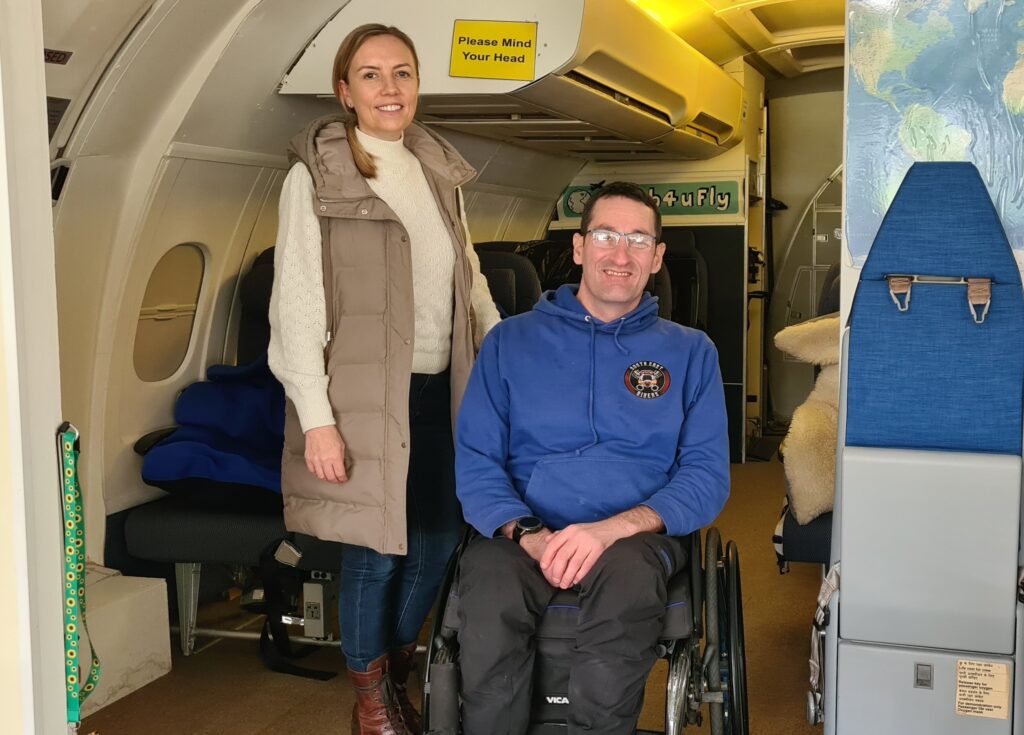Chris is a Quantity Surveyor and former Head of IT. Until he turned 50 he was an incredibly active person – playing a lot of squash and walking for miles whenever he and his wife Jack went away. After being diagnosed and successfully treated for cancer in 2021, Chris received a stem cell transplant to prevent the cancer returning. Unfortunately, he developed Graft vs Host Disease (GvHD) and a year later the immune suppressant used to treat this condition caused a virus to attack his brain. After 2 years of decline at home, Chris eventually came to QEF for neuro rehabilitation after losing much of his function and mobility and now receives physiotherapy and occupational therapy as an outpatient. His wife Jack says, “He is amazing but it’s so frustrating for him not to be able to do things for himself. His chemo for cancer was tolerable but this has been way worse.”

Chris and Jack tell their story:
“In January 2021 I got COVID which alerted the hospital to the fact that I had leukaemia. They managed to clear the leukaemia with chemo and I was in remission. But the hospital knew it would come back as there was a genetic mutation they could track. So they recommended I have a stem cell transplant. I was very lucky as my sister was a full match for me.
I was doing really well. But in December 21 I developed Graft vs Host disease (GvHD) which was the stem cells attacking my organs. It mainly affected my skin and guts, so I was admitted to The Royal Marsden and I wasn’t discharged until September 22. They put me on really high immune suppressants. The GvHD makes my skin very sore, but it also affects the fascia which makes everything very stiff, especially my joints.”
Jack adds, “February was the lowest point as he had lost so much weight due to the gut GvHD causing constant diarrhoea; he was down to just 45kg. He needed an operation on his bowel but they were worried he wouldn’t come through it because he was so weak. In the end it was fine but he was in ICU after the operation and then had to learn to walk again because he had got so weak.”
Chris continues, “When I was discharged I needed to rebuild my strength which went well and by November 22 I was able to walk 15,000 steps with a walking stick. But in December I was feeling a bit unbalanced – my vision wasn’t right. I had an MRI and was admitted again and this time I wasn’t discharged until March 23. They thought I probably had something called PML (Progressive Multifocal Leukoencephalopathy) due to the immune suppressants allowing other things to develop. They found the JC virus in my blood which causes PML and attacks the cerebellum in your brain. It had attacked the bottom left of my brain and was causing stroke like symptoms. The treatments for GvHD and PML are completely opposite to each other. So I had a brain biopsy and they decided it must be the PML causing the latest symptoms and took me off all the immune suppressants.”
Jack adds; “The PML had caused left sided weakness like a stroke, he wasn’t eating, he had a lot of dizziness, and lost his strength and mobility again. We moved his bed downstairs and he needed to use a 4 wheel walker. This time he found it very difficult to build his strength and mobility back up. He couldn’t absorb any nutrients to develop his muscles and the skin GvHD had got worse, causing stiff tight joints which further limited his movement.
Although we paid for weekly hydrotherapy and physio sessions, it became clear that he was getting worse and many of the medical professionals felt he needed inpatient rehabilitation, but we couldn’t get funding. The community OT was also giving advice on adaptations to the house and provided transfer equipment, as our children and I were literally lifting him from the wheelchair to the bed.
By September 24 he just couldn’t get down the steps to leave our house anymore and it became too hard for him to get in and out the car. So he was stuck in the house until February 25 when we had a ramp built and we got a Wheelchair Accessible Vehicle in May 25. But we could see he was declining.”
When the residential placement finally came through at QEF Chris was unable to use the walker anymore and they had bought a cheap wheelchair. Jack adds, “Most people come here straight from hospital so it’s an in-between step before home. But Chris had been at home for over a year and he’d got to a point of resignation, as he was just getting worse. He was willing to give it a go as everyone else was saying it would help, but it was too much for him and he discharged himself. It was frustrating as we had fought so long for it, but I could also see that it wasn’t right for him – he’d spent so long in hospital already.”
His funding authority amended his referral to provide intensive outpatient therapy at QEF for 12 weeks, so Chris currently comes in three days a week for Occupational Therapy and Physiotherapy sessions each day. Chris uses the Saebo Moss during his OT sessions which eliminates gravity and helps to increase his range of movement in his arms, and the standing machine during his physio sessions which helps to build his strength in his legs and works his muscles. Jack says, “He does a lot at home but he needs the machines QEF has here.”
Jack continues, “We don’t know what the future holds. The team at QEF are trying to stop him regressing, trying to get him to stabilise, but it feels like it needs to be intensive for that to happen. He still has GvHD of the skin so everything is incredibly tight. Even if you stretch him its immediately tight again, the flexibility doesn’t stay. He is amazing but it’s so frustrating for him not to be able to do things for himself. The damage done by the gut GvHD also impacts as he is still finding it hard to put on weight despite a good diet.
But we know to count our blessings – Chris’s company has been supportive and we have some amazing friends. Our children were grown up when this happened so they could help too. We are both very grateful that his life up to 50 has been great. He’s calm but this does get to him. We’ve got 12 weeks of outpatient therapy. I don’t know what happens after that. We are trying to find the optimum of what he can do.”
Chris says “I have great support at home. My wife has reduced her hours and now works one a day a week and my son works from home on that day. My sister and even my 87 year old mum help us out sometimes. I feel well supported by all the therapists at QEF and I am grateful that I get to work with them but still have the comforts and freedom of home.”


